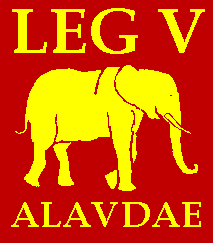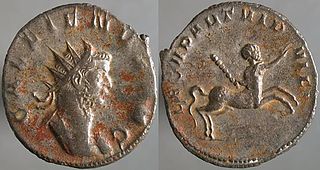
Legio II Augusta was a legion of the Imperial Roman army that was founded during the late Roman republic. Its emblems were the Capricornus, Pegasus, and Mars. It may have taken the name "Augusta" from a victory or reorganization that occurred during the reign of Augustus.

Legio I Minervia was a legion of the Imperial Roman army founded in AD 82 by emperor Domitian, for his campaign against the Germanic tribe of the Chatti. Its cognomen refers to the goddess Minerva, the legion's protector. There are still records of the I Minervia in the Rhine border region in the middle of the 4th century. The legion's emblem is an image of goddess Minerva.

Legio V Alaudae, sometimes also known as Legio V Gallica, was a legion of the Roman army founded in 52 BC by the general Gaius Julius Caesar. It was levied in Transalpine Gaul to fight the armies of Vercingetorix, and was the first Roman legion to comprise non-citizens. Historians disagree whether the legion was destroyed during the Batavian rebellion in AD 70, or during the First Battle of Tapae.

Legio VIII Augusta was one of the oldest legions of the Imperial Roman army.

Legio XXX Ulpia Victrix was a legion of the Imperial Roman army. Their emblems were the gods Neptune and Jupiter and the Capricorn. Ulpia is Trajan's own gens (Ulpia), while the cognomen "Victrix" means "victorious," and it was awarded after their valiant behaviour in the Dacian wars. The legion was active until the disbandment of the Rhine frontier in the beginning of the 5th century.

Legio IV Scythica, also written as Legio IIII Scythica, was a legion of the Imperial Roman army founded in c. 42 BCE by the Roman general Mark Antony, for his campaign against the Parthian Empire, hence its other cognomen, Parthica. The legion was still active in the Roman province of Syria in the early 5th century.

Legio II Parthica was a legion of the Imperial Roman army founded in AD 197 by the emperor Septimius Severus, for his campaign against the Parthian Empire, hence the cognomenParthica. The legion was still active in the beginning of the 5th century. The legion's symbol was a centaur.

Legio II Armeniaca was a legion of the late Roman Empire. This legion may have been garrisoned in the Roman province of Armenia, but later, together with its twin, I Armeniaca, it was moved into the field army as a pseudocomitatensis legion. The legion is reported to have built a camp in Satala. According to Ammianus Marcellinus, in 360 AD. II Armeniaca was stationed in Bezabde with II Flavia Virtutis and II Parthica. When Shapur II besieged and conquered the city, killing many of the inhabitants. The II Armeniaca however, survived, since it is cited in the Notitia Dignitatum as being under the command of the Dux Mesopotamiae.

The Legio II Flavia Constantia was a comitatensis Roman legion, created by Diocletian or Galerius, probably in the years 293, 296 or 297.
Legio II Isaura was a pseudocomitatensis Roman legion, levied no later than under Diocletian, and possibly already present under Probus. As their name suggests, II Isaura and its twin legion III Isaura were guarding the Isauria territory at the time of the Notitia Dignitatum, to defend it from the incursions of the mountain peoples. It is possible that in the beginning they were supported by I Isaura Sagittaria. According to Ammianus Marcellinus, in 360, they were stationed in Bezabde with II Armeniaca, and II Parthica, when the king of Persia, Shapur II besieged and conquered the city, killing many of the inhabitants.

Legio I Isaura Sagitaria was a pseudocomitatensis Roman legion. The legion was probably created by emperor Probus. It is possible that in the beginning it, together with the II and III Isaura, it was used to defend the Isauria region, The legion campaigned against the tribes of Cilicia. As its name suggests, its legionaries could be used also as archers, an uncommon feature for Roman legions. According to Notitia Dignitatum, in the beginning of the 5th century the I Isaura was under the command of the Magister Militum per Orientem.

Legio II Flavia Virtutis was a comitatensis Roman legion, levied by Emperor Constantius II (337–361), together with I Flavia Pacis and III Flavia Salutis.
Legio I Iovia was a Roman legion, levied by Emperor Diocletian (284–305), possibly together with II Herculia, to guard the newly created province of Scythia Minor. The cognomen of this legion came from Diocletian's attribute Iovianus, "similar to Jupiter". According to Notitia Dignitatum, at the beginning of the 5th century I Iovia was still in its camp on the Danube. The legion may have even survived the fall of Rome and continued to serve the Byzantine empire.

Roman Armenia refers to the rule of parts of Greater Armenia by the Roman Empire from the 1st century AD to the end of Late Antiquity. While Armenia Minor had become a client state until it was incorporated into the Roman Empire proper during the 1st century AD, Greater Armenia remained an independent kingdom under the Arsacid dynasty. Throughout this period, Armenia remained a bone of contention between Rome and the Parthian Empire, as well as the Sasanian Empire that succeeded the latter, and the casus belli for several of the Roman–Persian Wars. Only in 114 would Emperor Trajan conquer and incorporate it as a short-lived Roman province.
Armeniaca, a Latin word meaning from Armenia, may refer to :
The Armenian Legion may refer to:
Legio V Parthica was a legion of the Roman Empire garrisoned in Amida, Mesopotamia, established by the Roman emperor Diocletian (284–305), who reorganized the eastern frontier. The legion is described by the historian Ammianus Marcellinus. The cognomen "Parthica" was an archaism, as the Parthian Empire was already replaced by the Sasanian Empire at the time of the establishment of the legion.

Legio I Flavia Constantia was a Roman legion, mentioned in the Notitia Dignitatum as a comitatenses unit stationed in the Eastern Empire.
The Legio I Illyricorum was a Roman Legion stationed in Qasr el-Azraq and Palmyra; it is mentioned in the Notitia Dignitatum. According to many ancient sources, it was stationed within the Eastern Half of the Roman Empire, under emperor Aurelian.










